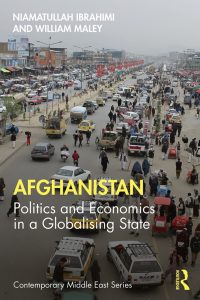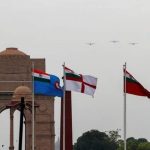
Nearly two decades have passed since the overthrow of the Taliban regime, still, Afghanistan remains the least peaceful and the most unstable country in this changing global order and the situation can only be expected to deteriorate under a profound and pervasive sense of uncertainty and insecurity as the U.S. troops are about to withdraw the war-torn country after 20 years of its invasion. With the completion of this withdrawal, many concerns have been raised about the future of Afghanistan and the re-emergence of Taliban 2.0. Afghanistan: Politics and Economics in a Globalizing State offers a complete overview from the formation of the Afghan state, its past and present political scenario, economic challenges faced by the country to its contemporary international relations, which will enable the readers to analyse the background of this war-torn country for making a better judgement about its future.
The first segment of the book introduces some of the key features that makes Afghanistan unique and how it acquired a distinctive character as a rentier state. The authors have also outlined a complex range of domestic and external factors that led to the breakdown of the state, giving rise to a set of challenges with which Afghan political and social actors have been trying to deal since the 2001 international intervention. The second chapter presents the various different types of politics that the country has observed in the past two decades which might help us to predict the future of Afghan politics after a complete withdrawal of the U.S. troops. The next chapter highlights and examines the most important facets of Afghan economy. Lastly, the books discuss how Afghanistan’s geopolitical location and its international relations has shaped the peace-building and stabilising process and made it even more complex and difficult in the post-2001 period. The section also reflects upon some factors that are likely to shape Afghanistan’s uncertain future.
The introduction scrutinizes the nature of Afghanistan by describing it as a complex country because of the diverse landscape it consists of, from desert plains, green valleys to the rugged mountains. Other than the physical features, factors such as the ethnically and linguistically diverse population have also added to the complexity of this war-torn country. Afghanistan is often viewed as a damaged and poor nation even before the 1978 coupe and the Soviet invasion of Afghanistan in 1979. The country has also faced enormous human displacement, civilian casualties and destruction of its infrastructure because of the disputable nature it carries. The authors have also described the strategic location of the land-locked country as hapless for its nationals whose lives have been drastically affected because of the buffer role it has played between the rivals, for example, in the 19th century Afghanistan was widely seen as a buffer state between the stretching Russian Empire and the British Raj in India. According to the authors, Afghanistan’s strategic location has made it a theatre for competition between regional rivals with an incentive to compete with proxy forces rather than direct confrontation. Afghanistan has not only been a buffer state, but it has also been labelled as a crossroad, linking different regions of the world not only in a cultural sense but also in economic aspects. Afghanistan has also been described as a romanticised and exotic country because of its rich cultural heritage, oral tradition as well as literary, artistic and musical achievement. The emergence of Afghan as a state was a complicated process which to an extent has affected the character that it came to assume over a period of time.
The chapter on state formation first explores the meaning of the word state and in specific makes a distinction between a territorial state which is close or equivalent to the word country and the second sense of the word state is more complex and contested, it refers to the political and administrative structure within the territorial boundaries of a state and performs various functions. The authors have also expressed scepticism about histories of state formation in general, according to them the accounts of state formation usually contain substantial elements of myth as the claim of responsibility for establishing a state in the past can easily be transformed into a right to control the present and future of a state and similarly Afghanistan has witnessed such diverse discourses about its state formation.
State formation in Afghanistan was a complicated process that has continuously shaped the character of present-day Afghanistan. Over time the country has transformed into a rentier state completely dependent upon unstable sources of income. And it is rightly observed by the writers that rentier states are more likely to develop into an authoritarian regime that will resist democratisation. In such cases ruling elites usually rule through the distribution of foreign rents rather than the mobilization of domestic revenues, hindering the states to invest in the productive centres of the economy.
It is true that Afghanistan has gained a greater strategic significance for the global powers only after the Cold War when it refused to join any alliances which were backed by two superpowers and in 1955 it decided to participate in the Bandung Conference as one of the founding members of the Non-Alignment Movement. Though Afghanistan portrayed itself as a neutral actor during the Cold War era, it still continued to attract aid from one of the two major powers. For instance, after US turned down to invest in Afghanistan after its refusal to join US-backed Baghdad Pact in 1955 which further led to the formation of the Central Treaty Organization (CENTO), the country turned over to the Soviet Union and received more substantial military and financial aid and during the 1970s USSR was by far the largest source of aid and soft loans for Afghanistan and by 1978 both the US and the Soviet aid to Afghanistan had amounted to $471 million and $1.265 billion respectively. Thus, the text rightly says that the Musaheban approach turned Afghanistan into a complete rentier state.
According to Ibrahimi and Maley, the single most decisive event shaping the modern history of Afghanistan has been the overthrow of the republican regime of Mohammad Daoud. The coup laid down the foundation for complex new conflict formations and further the Soviet invasion of Afghanistan aggravated the problems of the new regime and resulted in the formation the Mujahideen movement. And the events of 1970s have continued to shape the lives of ordinary Afghans even in the twenty-first century.
Politics in Afghanistan is as complex as Afghan society and it is infused in everyday life for practical reasons and the chapter on Politics covered five different types of politics evidenced in the Afghan society. Institutional politics of Afghanistan has a formally strong executive presidency which reflects that Afghanistan was in need of a strong leadership but so far, the office of president has not provided any cohesive and decisive leadership as the architects hoped for. Apart from institutional politics, network politics, warlord politics, contentious politics and identity politics which has been explained very intensely by the authors, played an equally important role in the context of the ongoing insurgency.
The subsequent chapter deals with the key challenges faced by the Afghan economy from the issue of dependence on foreign aid, unravelling the relationship between the state and the entrepreneurs, challenges faced by the Afghan agriculture in an environment where opium cultivation is hugely profitable to the issue where Afghanistan’s economic developments fit into the wider world economy. Though the authors have deeply elaborated on these challenges faced by the Afghan economy, the have also highlighted the most encountered myth in the last four decades, which claims that the Afghan economy has collapsed. The authors have contradicted this myth by considering the bulk of Afghan population residing inside the country who has been surviving not on the strength of foreign aid or state policy but on the circular flow of income that might have been flawed but has proved capable of fulfilling the daily needs of millions of people.
The next chapter deals with Afghanistan’s international relations and why Afghanistan’s place is important in the world and how it can utilise its significance strategically for its own purposes. Through the facts presented by the authors it is evident how Afghanistan’s neighbourhood comprising of India, Pakistan and Iran and broadly Russia and China and to a greater distance United States has limited the aspirations of Afghanistan, majorly due to the complex relationship that it shares with these countries. Hope for a better future for Afghanistan has been expressed by the writers as they emphasize the positive role that globalization has played and the opportunities it has created for Afghans which they never previously enjoyed. The text concludes with a hope for a better future for the country which can largely be shaped by the globalized generation of younger Afghans with a very different approach to see the world as compared to their elder generations as they have the ability to rage against the dying of the light as rightly said by Dylan Thomas. The active involvement of the younger Afghans can offer this war-torn country, an escape route from decades of sorrow and misery.
Overall, this book is a significant text in the light of the ongoing U.S. withdrawal and in predicting the subsequent future developments in the war-torn Afghanistan once the termination is complete. The book provides a complete backdrop of Afghanistan behind its state formation to its present-day character of a rentier state. The text also enables the readers to have a broader perspective in analysing the picture of Afghanistan and to come up with more holistic predictions and suggestions for a more stable and peaceful Afghan administration mandated by the will of its people.













